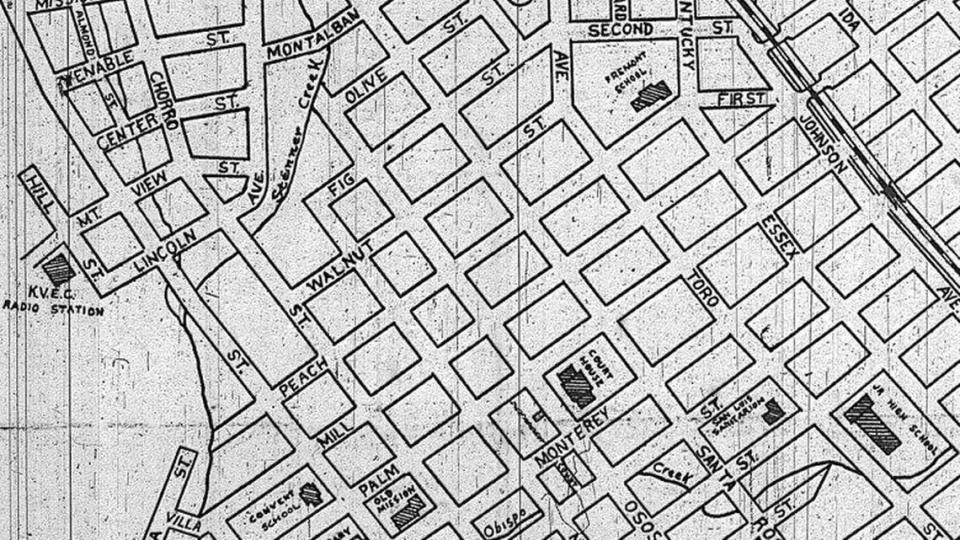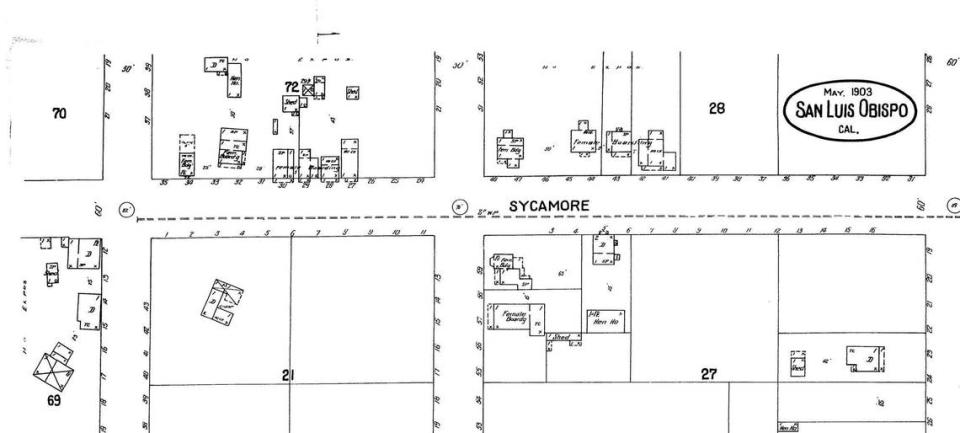SLO once had a red-light district so notorious, the city renamed the street
What did Edwin E. Grant do to make constituents mad?
The California state senator from San Francisco was targeted in 1914 by the state’s second successful recall and became the shortest serving legislator of the decade of the 1910s, in office only 22 months.
Grant wrote the Red Light Abatement Law and later was the author of the 1952 pamphlet “Redlight Padlocking.”
He advocated punishing property owners who facilitated prostitution and liquor use by locking them out of their properties for a year.
Grant’s San Francisco district included the city’s red-light and financial districts, where he was removed from office by a three-to-one margin, according to Wikipedia.
After getting booted from office, Grant took his crusade around the state, visiting San Luis Obispo in 1919 and targeting the city’s notorious red-light district on the then-named Sycamore Street a few blocks north of downtown.
On May 31, 1919, the Daily Telegram published a long, lurid letter of complaint from Grant that was filed with the grand jury.
It ran at the bottom of page 1 below a related story that included full names and addresses for nine Sycamore Street addresses and one on Osos Street.
The letter careens between sympathy and harsh judgment but also gives a window into a seldom reported story.
Grant’s crusade would not change Sycamore Street, as it would remain notorious for another two decades.

On July 23, 1940, the then Telegram-Tribune editorialized that Sycamore Street had become a “civic eyesore and human cesspool.”
The paper celebrated that the health department and district attorney had cracked down in March and the fire department had condemned some of the housing as fire traps.
By the end of the month, a city ordinance renamed it to Walnut Street in keeping with the other tree-named streets in the section. Palm, Peach, Sycamore/Walnut, Fig and Olive.
The San Luis Obispo Police Station is located there now, but the street name has been changed to protect the innocent.
Here’s the letter from Edwin Grant that was published in 1919:
Grant’s Letter Sent Today to the County Grand Jury
May 31, 1919 — Mr. D. J. Riley, Foreman San Luis Obispo County Grand Jury, San Luis Obispo, Calif.
My Dear Sir: For the past several days I have, in co-operation with citizens of San Luis Obispo County, been conducting an investigation of vice conditions in the County of San Luis Obispo. Because of the vast amount of evidence which we have uncovered and the particular circumstances under which these Houses of Prostitution are operating, apparently under some kind of agreement that they may continue in their violation of the law without any molestation, I beg to suggest that your Grand Jury will find a very fruitful field for investigation.
For instance: a system seems to be in vogue here whereby these house are actually sold to the Underworld Women at such a high contract price, on an agreement that they will not be disturbed in the carrying on their vicious business of debauchery.
For instance, a woman at 1016 Sycamore St., whose name is Louise, told me personally that she is paying $1,400.00 for her old shack on terms of $200.00 down and $70.00 per month, and that she has been positively assured that under these conditions she might continue to run her place as a House of Prostitution. Many of these unfortunate women gave me information of this character regarding the conditions under which they were compelled to purchase their cribs to be used in violation of the law.
Other important information is available that the woman stated that the watch which had been placed on “The Line” had been withdrawn, under peculiar circumstances, and that the women were assured that they would be undisturbed in their business, also that the line had been closed on account of the recent city election and is being reopened now that the wind had blown over. Many corroborating circumstances, with information I received of the failure of some officials to enforce the law, is available for the investigation of the Grand Jury.

The fact that this so-called segregated district, which many claim they fear to remove lest the prostitutes be driven into the residence district, is itself located in the residence district of San Luis Obispo, which presents in itself a very interesting situation.
I have seen little children forced to pass by these houses of crime only two diagonal blocks from the [Fremont] school house and again within easy access of the State Polytechnic school, as these women were yelling at the passers-by to come into their houses, while at night time the district is crowded with drunken men, reeling around from one house to another, and well dressed men sneaking around in the dark shadows and into these houses of shame, while a veritable carnival of debauchery and crime goes on and in and around these Bawdy houses.
You will be interested in this connection to know, that following a request by a delegation of San Luis Obispo citizens, headed by Rev. O.M. Butterfield, evidence on ten Open Houses of Prostitution had been submitted to Dist. Atty. R. Van Wormer. These have been made the basis of Red Light Abatement Proceedings, which are being filed in the Superior Court of San Luis Obispo County today through the expeditious action of the District Attorney. I was quite surprised to learn, in this connection, that a previous official charged with the enforcement of the law, had stated that Red Light Abatement Proceedings could not be brought against these women because they own the houses, when as a matter of fact, under the Red Light Abatement Law and also Supreme Court decision thereon, the owner is the one held absolutely liable for the character of business that is being carried on is his or her house.
I have partial evidence of two other houses of prostitution in this district, and I am also investigating certain rooming house conditions in the main part of the city, regarding which I may make a report later on.
662 Osos Street.
At 662 Osos street, I met a large, fat, sleek, greasy-looking woman named Virginia King running a Bawdy House with a girl named Dixie as one of her inmates. Dixie stated that she was having a house next door, at 670 Osos street, fixed up to run a parlor house where she planned to do a land office business. So flagrant was this other proposed violation of the law that the carpenters are even now working at this place, remodeling it under the direction of the said Dixie.
920 Sycamore Street.
I found this place occupied by a woman named May, who stated that she no longer hand any fear of police interference.
912 Sycamore Street.
At 912 Sycamore street, a woman named Jane, following the orders to open the Red Light District, had just come in when I arrived there. While I was there, three trunks were brought in by an auto truck. She assured me that under an agreement whereby she bought the property she was assured that she might ply her trade there for several years.
926 Sycamore Street.
Evelyn is the name of the woman at 926 Sycamore Street, from whom information of similar feeling of security was obtained.
930 Sycamore Street.
A woman named Ida occupies this crib and usually has the place crowded with men.
940 Sycamore Street.
At 940 Sycamore Street, another woman named May, who seems to have considerable to do with the line of cribs in that block, also runs her bungalow as a house of prostitution. I also found her at Jane’s place directing Jane how to fix up the house.
1019 Sycamore Street.
Blanche, the occupant of 1019 Sycamore Street, hailed us as we went by, and among other things stated that under certain restrictions she might continue her business unmolested.
898 Sycamore Street.
At 898 Sycamore Street, corner of Morro Street, is a bungalow well fitted up both inside and out and occupied by a woman named Stella. Stella stated that she had been there two years and that she had a unique location for a house since a class of so-called respectable men, who didn’t want to be seen in the district, might sneak around on another road to her house.
1013 Sycamore Street.
At 1013 Sycamore street, Leah, a girl 28 years of age, who stated that she had been there two years and had been given assurance that she might continue her business, sold me a bottle of booze as part of the unlawful business she was carrying on.
1016 Sycamore Street.
This is the unfortunate woman named Louise, who gave us the figures showing the wholesale way in which she was being victimized out of $70 a month for shack which would probably not rent for more than $5.
I have given your Grand Jury in this letter merely a rough statement of a small portion of the facts uncovered in this investigation. I would respectfully suggest that you carry on a rigid investigation with the view of indicting, for obtaining money under false pretenses, any man or woman, official or unofficial, who may be found grafting off these unfortunate women by selling them these houses at such exorbitant figures and terms, under an agreement that they would be immune from justice.
All of that portion of the evidence which has been completed in this investigation has been turned over to the District Attorney and is available for your Grand Jury at any time.
Very respectively yours,
EDWIN E. GRANT
Law Enforcement Executive

